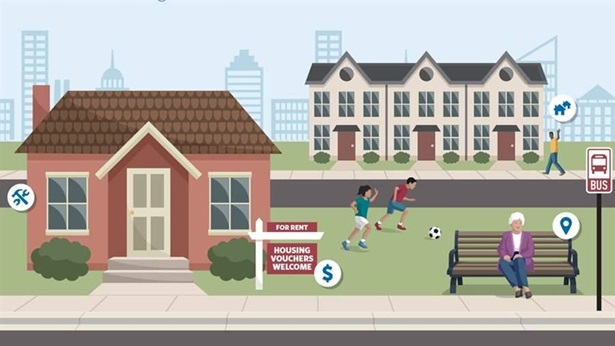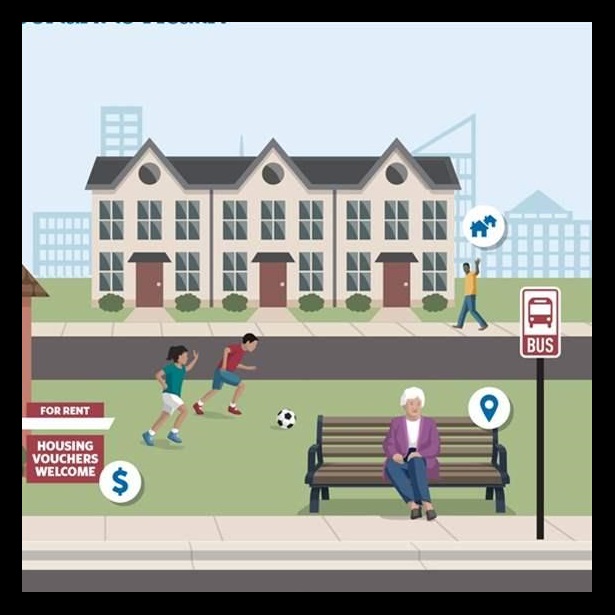Guidance for the Public Health Sector
Health impact assessment and housing
 © Christopher Wesser
© Christopher WesserPublic health professionals can engage housing experts and build awareness of the benefits of health impact assessments in a variety of ways.
About the brief
This brief draws from a report developed by the National Center for Healthy Housing, the Health Impact Project, and the Center for Housing Policy that summarizes a review of 40 housing HIAs conducted in the U.S. between 2002 and 2013, provides guidance for future housing assessments, and offers a helpful tutorial on housing programs.
Overview
Many of the nation’s most pressing public health problems, such as asthma, depression, diabetes, and obesity, are influenced by the places where people live, work, and play. Policy decisions that affect housing quality, affordability, and location as well as neighborhood characteristics can influence whether these places are supportive of or detrimental to community health and well-being and can play important roles in reducing or even preventing disease.1 Unfortunately, public health professionals often are not part of the development decision-making process, which can result in a missed opportunity to ensure that health is effectively considered.
Public health and housing professionals know that the health impacts of housing decisions can last decades, affecting residents over their lifetimes and across generations. Health impact assessments (HIAs) provide an opportunity for these sectors to build strong partnerships dedicated to the shared goal of ensuring that housing projects, policies, and programs promote the best possible health and quality of life for residents. HIAs help identify the potential health effects of policy, program, and project proposals, including those related to housing; offer practical options for maximizing health benefits and minimizing health risks; and leverage the resources, strengths, and expertise of each sector.
This brief provides public health professionals with information about major housing programs and policies, identifies key decision-makers, and discusses how public health professionals can effectively integrate health into housing decisions.
Connecting housing policy with health
Research has consistently demonstrated the link between housing and health. For example, a lack of affordable housing limits people’s ability to acquire and maintain adequate shelter and meet other basic needs. Financial constraints can force families to choose between paying for rent, utilities, food, or medical care. The design and quality of housing can affect health outcomes such as asthma, cardiovascular disease, cancer, and injury, while the location and the social, economic, and built environments of the surrounding neighborhood can have implications for health through access to supportive resources, opportunities, and social networks and relationships.2
Housing programs and policies that target low-income families offer unique opportunities to use HIAs to integrate health considerations into the decision-making process with particularly high potential impact, because housing-related health issues disproportionately affect this population. Additionally, stakeholder engagement informs all steps of the process, so HIAs can help ensure that the perspectives and experiences of low-income households are taken into account in housing program and policy decisions.
What Is a Health Impact Assessment?
Health impact assessments help decision-makers make better choices by bringing together scientific data, health expertise, and public input to identify the potential and often overlooked public health effects, both positive and negative, of proposed laws, regulations, projects, policies, and programs. HIAs broadly consider environmental, social, and economic factors related to health and evaluate the possible impacts of a proposed project, plan, program, or policy on the health and well-being of the community. HIAs employ a variety of data sources, including qualitative and quantitative analyses and input from stakeholders, to identify health concerns related to the proposal and determine how these impacts may be distributed among the population, especially vulnerable groups such as seniors, children, and low-income families.
Using HIAs to engage with housing
HIAs create unique opportunities for practitioners, stakeholders, and decision-makers to work together to consider the health impacts of proposed housing actions. Housing professionals understand housing and community development through a specific lens, while public health professionals concentrate on other angles. HIAs can also help enhance community engagement and transparency in housing decision-making by bringing together affected communities, public health and housing professionals, and decision-makers to help ensure that all perspectives and priorities are included.
Many housing agencies do not have the financial resources or public health capacity to conduct an HIA. Partnering with public health professionals as well as public health academics may also present opportunities to pool resources. Public health professionals can engage housing experts and build awareness of the benefits of HIAs in a variety of ways:
- Offer trainings. HIAs are new to many housing professionals. In addition to collaborating with them on HIAs, health professionals can provide trainings targeted to housing and community issues. They also can reach out to development intermediaries such as NeighborWorks America, which trains nearly 11,000 housing and community development professionals annually, or approach other organizations such as Enterprise Community Partners and the Local Initiatives Support Corporation for resources to support housing HIAs.10
- Provide public health data and expertise. Local, state, and federal public health professionals have critical knowledge to contribute in identifying potential health impacts of a proposed housing decision and can assist housing professionals is accessing and using agency data systems (e.g., neighborhood health indicators, utilization data from hospitals, and prevalence rates of chronic conditions). Public health professionals may also have the capacity to analyze and map these health data to assist decision-makers and support housing professionals in communicating the benefits of their work. This expertise can supplement housing professionals’ own extensive data and resources to create a more complete picture of the potential effects that housing proposals may have on public health and to support the monitoring of health impacts over time.
- Offer testimony. Public health professionals can use HIA findings in expert testimony presented to local, state, or federal officials. For example, an HIA in Flagstaff, Arizona, examined the potential health effects of a local rezoning proposal intended to accommodate new student housing. The HIA found that the proposed development could result in displacement and increased housing costs—which could in turn present a range of physical and mental health risks—for residents in an existing mobile home park and could affect the health of other residents through changes in traffic safety and crime.11 Members of the HIA team and several community partners cited the findings and recommendations from the HIA in written and oral testimony to the local planning and zoning commission.12
- Meet with political and housing decision-makers. HIA practitioners can meet with local, state, and federal officials and legislators to discuss the process, findings, and recommendations. The Aerotropolis HIA team in Atlanta scheduled meetings with stakeholders and decision-makers, including the developer, planners, and officials from the various cities that would potentially be affected by the proposed action; health and environmental officers; and airport representatives.13
- Give public presentations. Health professionals can present findings to housing and community development groups to illustrate the benefits of using HIAs for proposed actions. For example, findings have been presented at the New Partners for Smart Growth Conference, which brings diverse disciplines together to collaborate on smart growth issues, and local and state community development corporation conferences that address housing and economic development issues.
- Develop policy briefs, project briefs, and case studies. HIA practitioners have prepared briefs and presentations for various local and state committees and legislatures. The authors of the North Carolina Zoning/Design and Aesthetic Controls S.B. 731 HIA presented the findings to members of the Town of Davidson’s board of commissioners. The authors of an HIA on the proposed redevelopment of the Coffelt- Lamareoux public housing property in Phoenix, Arizona, interviewed several stakeholders to get feedback on the impact of the process, which they featured in a case study.14
- Publish HIA findings in peer-reviewed housing and health journals. Publication in the peer-reviewed literature, as well as in reports and other venues, can help raise awareness of the utility of HIA. An article on the Page Avenue HIA highlighted lessons learned such as the value of flexible, organized, interdisciplinary teams and the importance of engaging community stakeholders and decision-makers before, during, and after an HIA.15
- Learn common housing terminology. Everyone is familiar with the terminology used in his or her own field but often does not understand common terms from other disciplines. For example, in public health circles, “CDC” generally refers to the Centers for Disease Control and Prevention; in housing, it often is shorthand for community development corporations, which can be prime audiences for public health professionals to talk with about HIAs. These nonprofit organizations were created to lead community change efforts and are often affordable housing developers. Public health professionals should consider reaching out to local CDCs and CDC associations at the local and state levels to build support for HIAs.
- Engage in the collection and monitoring of community indicators. Although public health professionals may be involved in this process, housing professionals may not be—or vice versa. Public health professionals involved in community indicator projects can reach out to housing and community development groups and encourage them to participate.16
- Pursue joint funding. Both housing and public health organizations are looking for innovative ways to leverage shrinking resources.
Conclusion
Although public health professionals may not be able to get involved in every housing policy change, they can help ensure that health is considered in those decisions by building stronger relationships with professionals in the housing sector. Collaborating on housing HIAs and supporting efforts by the housing community to improve construction and design of buildings and neighborhoods will maximize positive health impacts and minimize the negative ones that are so prevalent in communities across the country.
Like public health agencies, housing and community development organizations face significant resource constraints and are subject to a complex array of federal, state, and local laws and regulations. HIAs can help them navigate these challenges by building support for well-planned projects, allaying community concerns, and streamlining the way health concerns are integrated and addressed. Through the use of HIA, the two sectors can build collaborations that leverage their unique assets toward their shared goal of improving community health and quality of life.
Endnotes
- Paula Braveman et al., Neighborhoods and Health, Robert Wood Johnson Foundation, accessed Oct. 22, 2015, http://www.rwjf.org/content/dam/farm/reports/issue_briefs/2011/rwjf70450.
- David E. Jacobs and Andrea Baeder, Housing Interventions and Health: A Review of the Evidence, National Center for Healthy Housing (2009), http://www.nchh.org/Portals/0/Contents/Housing%20Interventions%20and%20Health.pdf; Mark Nord and Linda S. Kantor, “Seasonal Variation in Food Insecurity Is Associated With Heating and Cooling Costs Among Low-Income Elderly Americans,” Journal of Nutrition 136, no. 11 (2006): 2939–44, http://jn.nutrition.org/content/136/11/2939.full.pdf+html; National Energy Assistance Directors’ Association, “National Energy Assistance Survey” (November 2011), http://neada.org/wp-content/uploads/2013/05/NEA_Survey_Nov11.pdf; Tina L. Palmieri and David G. Greenhalgh, “Increased Incidence of Heater-Related Burn Injury During a Power Crisis,” Archives of Surgery 137, no. 10 (2002): 1106–08, doi:10.1001/archsurg.137.10.1106; Lynn Page Snyder and Christopher A. Baker, Affordable Home Energy and Health: Making the Connections, AARP Public Policy Institute (2010), http://assets.aarp.org/rgcenter/ppi/cons-prot/2010-05-energy.pdf; P. She and G.A. Livermore, “Material Hardship, Poverty, and Disability Among Working-Age Adults,” Social Science Quarterly 88, no. 4 (2007): 970–989, doi:10.1111/j.1540-6237.2007.00513.x; Sarah A. Burgard, Kristin S. Seefeldt, and Sarah Zelner, “Housing Instability and Health: Findings From the Michigan Recession and Recovery Study,” Social Science & Medicine 75, no. 12 (2012): 2215–24, doi:10.1016/j.socscimed.2012.08.020; Christopher Jencks and Susan E. Mayer, “The Social Consequences of Growing Up in a Poor Neighborhood,” in Inner-City Poverty in the United States, National Research Council (Washington: National Academies Press, 1990), 111–186, http://www.nap.edu/openbook.php?record_id=1539&page=115; and Child Health Impact Working Group, Affordable Housing and Child Health: A Child Health Impact Assessment of the Massachusetts Rental Voucher Program (2005), http://www.pewtrusts.org/en/~/media/Assets/External-Sites/Health-Impact-Project/massachusettsrentalvoucherprogram.pdf.
- U.S. Department of Housing and Urban Development, “Public Housing Agency (PHA) Plans,” accessed Oct. 22, 2015, http://portal.hud.gov/hudportal/HUD?src=/program_offices/public_indian_housing/pha.
- U.S. Department of Housing and Urban Development, “Resident Advisory Board—PHA Plans,” accessed Oct. 22, 2015, http://portal.hud.gov/hudportal/HUD?src=/program_offices/public_indian_housing/pha/about/rab.
- U.S. Department of Housing and Urban Development, “Public Housing Programs: Choice Neighborhoods,” accessed Oct. 22, 2015, http://portal.hud.gov/hudportal/documents/huddoc?id=HUDPrograms2013-52.pdf.
- U.S. Department of Housing and Urban Development, “HUD Launches Groundbreaking Rental Assistance Demonstration to Preserve and Strengthen Public, Other HUD-Assisted Housing,” Jan. 10, 2013, http://portal.hud.gov/hudportal/HUD?src=/press/press_releases_media_advisories/2013/HUDNo.13-003; U.S. Department of Housing and Urban Development, “Rental Assistance Demonstration, Program Information,” accessed July 17, 2014, http://portal.hud.gov/hudportal/HUD?src=/RAD/info; U.S. Department of Housing and Urban Development, “HUD’s Public Housing Program,” accessed July 17, 2014, http://portal.hud.gov/hudportal/HUD?src=/topics/rental_assistance/phprog; Center on Budget and Policy Priorities, “Policy Basics: Introduction to Public Housing,” accessed Oct. 10, 2014, http://www.cbpp.org/cms/index.cfm?fa=view&id=2528; Center on Budget and Policy Priorities, “Chart Book: Federal Housing Spending Is Poorly Matched to Need,” accessed Oct. 10, 2014, http://www.cbpp.org/cms/?fa=view&id=4067; Barbara Sard and Will Fischer, “Preserving Safe, High Quality Public Housing Should Be a Priority of Federal Housing Policy,” Center on Budget and Policy Priorities (2008), http://www.cbpp.org/files/9-18-08hous.pdf; and U.S. Department of Housing and Urban Development, “Public Housing Agency (PHA) Plans,” accessed Oct. 15, 2014, http://portal.hud.gov/hudportal/HUD?src=/program_offices/public_indian_housing/pha.
- U.S. Department of Housing and Urban Development, “Housing Choice Vouchers Fact Sheet,” accessed Nov. 30, 2014, http://portal.hud.gov/hudportal/HUD?src=/topics/housing_choice_voucher_program_section_8; Center on Budget and Policy Priorities, “Policy Basics: The Housing Choice Voucher Program,” accessed Oct. 10, 2014, http://www.cbpp.org/cms/?fa=view&id=279; and The Urban Institute and Poverty & Race Research Action Council, Expanding Choice: Practical Strategies for Building a Successful Housing Mobility Program (2013), http://prrac.org/pdf/ExpandingChoice.pdf.
- U.S. Department of Housing and Urban Development, Programs of HUD: Key Programs, Offices, and Initiatives (2011), http://portal.hud.gov/hudportal/documents/huddoc?id=HUDProg2011RX.pdf; and U.S. Department of Housing and Urban Development, Housing: Project- Based Rental Assistance—2015 Summary Statement and Initiatives, accessed Oct. 22, 2015, https://portal.hud.gov/hudportal/documents/huddoc?id=fy15cj_pbra.pdf.
- Center on Budget and Policy Priorities, “Policy Basics: Section 8 Project-Based Rental Assistance,” accessed Oct. 23, 2014, http://www.cbpp.org/files/PolicyBasics-housing-1-25-13PBRA.pdf; and National Council of State Housing Agencies, “2015 Project-Based Section 8 Rental Assistance Q&A,” accessed May 12, 2015, https://www.ncsha.org/resource/2015-project-based-section-8-rental-assistance-qa.
- See, for example, the websites of NeighborWorks America (http://www.neighborworks.org/), Enterprise Community Partners Inc. (http://www.enterprisecommunity.com/), and the Local Initiatives Support Corp. (http://www.lisc.org/).
- Health Impact Project, “Zoning and Student Housing in La Plaza Vieja,” accessed Feb. 11, 2016, http://www.pewtrusts.org/en/multimedia/data-visualizations/2015/hia-map/state/arizona/zoning-and-student-housing-in-la-plaza-vieja.
- Ibid.
- Catherine L. Ross et al., Aerotropolis Atlanta Brownfield Redevelopment Health Impact Assessment, Center for Quality Growth and Regional Development at the Georgia Institute of Technology (2011), http://www.cqgrd.gatech.edu/sites/files/cqgrd/files/_AerotropolisHIA_Report_Final_Web.pdf.
- Lauren Blackburn and Katherine Hebert, “Senate Bill 731,” Town of Davidson board meeting (April 10, 2012), http://www.healthimpactnc.com/wp-content/uploads/2012/11/April-10-Presentation.pdf; and Debarati “Mimi” Majumdar Narayan, The Coffelt Case: A Case Study of the Coffelt-Lamoreaux Public Housing Redevelopment HIA, Catalyze Research & Consulting and the Local Initiatives Support Corp. (2014), http://www.pewtrusts.org/en/research-and-analysis/analysis/hip/hip-case-study-coffelt-lamoreaux-public-housing-redevelopment.
- Hoehner et al., “Page Avenue Health Impact Assessment.”
- Two organizations that work with indicator groups across the country are the National Neighborhood Indicators Partnership (http://www.neighborhoodindicators.org/) and the Community Indicators Consortium (http://www.communityindicators.net/projects).


America’s Overdose Crisis
Sign up for our five-email course explaining the overdose crisis in America, the state of treatment access, and ways to improve care
Sign up

Guidance for Housing Professionals
Health impact assessment and housing











